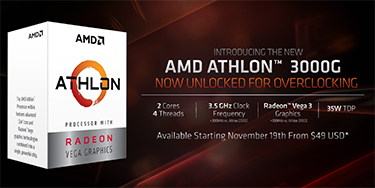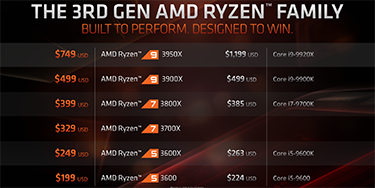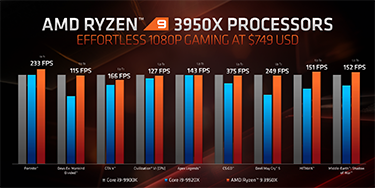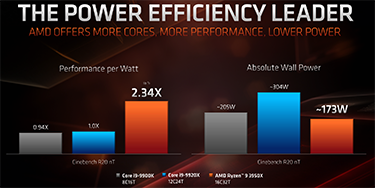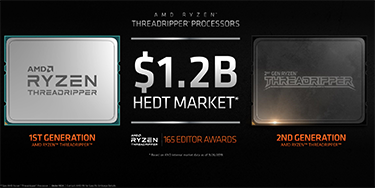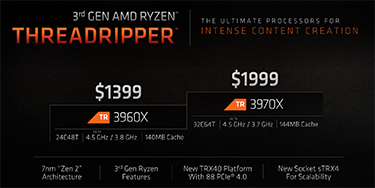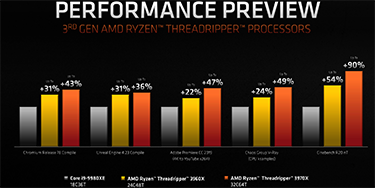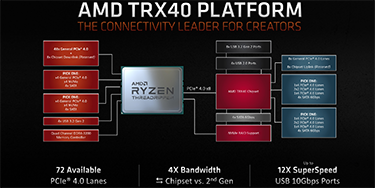AMD is today announcing updates to its Athlon, Ryzen, and Threadripper desktop CPUs in what it calls the Fall Update. Let's take each in turn.
Athlon 3000G - the budget king?
The least glamourous of the trio is the Athlon 3000G, though at only $49 SEP and plumbed with a 35W TDP, it is of genuine interest to any PC builder on a very tight budget.
This chip is interesting for a number of reasons. The dual-core, quad-threaded CPU, sitting on the pervasive AM4 socket, uses the same Zen+ (Picasso) architecture present a wide range of IGP-infused budget Ryzens, though it most closely resembles the Athlon Pro 300GE in silicon footprint, meaning the CPU, backed by dual-channel DDR4-2666 memory, is paired with Radeon 3 Graphics suitable for entry-level gaming.
The chip ships with a 3.5GHz CPU clock and 1.1GHz GPU frequency. According to AMD's own data, the base performance is superior than a significantly dearer Intel Pentium G5400, particularly so in light-load gaming. Extending the value and performance proposition further, the Athlon 3000G is unlocked. Internal testing shows it scales to an all-thread 3.9GHz easily enough, helped by AMD bundling in a 65W-capable cooler in the box.
Enabling the core, GPU and memory to scale unhindered leads to some impressive gains, if AMD's numbers are correct, and at just $49, Athlon 3000G looks like a really good bet for a cheap-as-chips build for those that cannot extend to a Ryzen 3 3000-series processor. Expect it to be on-shelf November 19.
Ryzen 9 3950X - 16 cores and 32 threads for mainstream AM4
Switching gears emphatically, more is already known about the $749 Ryzen 9 3950X. The 16-core, 32-thread processor headlines the Ryzen AM4 range, expanding the mainstream processor into the high-end desktop (HEDT) firmament.
Using the full complement of two CCDs each holding dual four-core CCXes (2x2x4), the range-topping chip is imbued with a total 72MB of cache (8MB L2, 64MB L3), carries the same 105W TDP as other high-spec Ryzens, and runs with a 3.5GHz base and 4.7GHz boost frequency.
Given that Ryzen 9 3950X ought to be using the finest pieces of 7nm silicon, AMD reckons the chip offers, by a hair, the highest single-thread performance from any Ryzen processor to date. And it goes without saying that with 16 cores and 32 threads at its disposal, it has class-leading multithreaded muscle.
In fact, so bullish is AMD, that it reckons Ryzen 9 3950X is as good as the Intel Core i9-9900K in gaming, hammers it in CPU-heavy applications, and offers around 2.5x better performance per watt, thanks to that 7nm process. Touted as a no-compromise solution for the power user and gamer alike, we won't have to wait long to seed if AMD's bold claims hold up - the processor is on-shelf November 25.
Interestingly, and curious on a processor of this ilk, AMD is introducing an eco-mode that reduces the chip's TDP from 105W to 65W. Such a move, designed for small-form-factor systems, limits performance to about 75 per cent of its unrestricted potential. If you are going frugal on the power, doesn't it make more sense to go for a much cheaper 65W Ryzen 7 3700 instead?
AMD is not bundling a retail heatsink with the Ryzen 9 3950X, leaving it instead up to the enthusiast to use their extant cooling. Last but not least, AMD says that AM4 motherboards need to be updated to BIOSes featuring the AGESA 1.0.0.4 microcode that amalgamates over 100 improvements. From a quick check just now, X570 chipset-based boards are beginning to support the latest platform update.
3rd Gen Threadripper also coming this month
Following on from the rumour mill going into overdrive, AMD confirms that it is releasing 3rd Gen Threadripper on November 25, too. The family initially consists of just two processors: TR 3960X and TR 3970X, housing 24C48T and 32C64T and priced at $1,399 and $1,999, respectively.
Based on the same Zen 2 microarchitecture powering the latest slew of Ryzens and Epyc CPUs, AMD makes improvements in every area. Compared to Zen+ powering 2nd Gen Threadripper, Zen 2 introduces double the L3 cache, higher frequencies, faster memory support, IPC improvements via enhanced architecture, and greater transistor density emanating from the leading-edge 7nm process.
During a briefing call earlier in the week, AMD reckoned 3rd Gen Threadripper is comfortably faster than any Intel Core processor, and it doesn't expect that situation to change appreciably with the imminent Cascade Lake-X update. In fact, comparing the 32C64T TR 3970X versus the also-32C64T TR 2990WX from the last generation, AMD's Robert Hallock reckoned the new head honcho can be up to 50 per cent faster in certain scenarios. Whether that's taking AVX workloads, where Zen 2 uses double-width 256-bit vectors, into account is unknown at present.
TDP is set at 280W for the new pair, which seems high given the power-efficient 7nm process, though AMD may well be giving 3rd Gen Threadripper room to breathe. That, or it's using silicon that doesn't quite make the Epyc grade.
Knowing how the latest Epyc series of chips lines up, which are a solid bellwether for how AMD is likely to construct 3rd Gen Threadripper, it is reasonable to assume that, at some point in the near future, AMD will release 48C96T and 64C128T TR parts, likely named TR 3980X and TR 3990X, though it clearly has no current need to do so.
AMD's not providing any under-the-hood details into the exact layout of 3rd Gen Threadripper at this juncture, but we expect the full gamut of information at the November 25 launch.
It's well-known that AMD champions socket longevity, citing it as a compelling reason to adopt Ryzen and Epyc CPUs. 3rd Gen Threadripper breaks that mould by eschewing the incumbent sTR4 and replacing it with sTRX4, which connects to the TRX40 chipset. This means that 3rd Gen Threadripper has no backward compatibility, and that 1st or 2nd Gen Threadripper cannot be used on this new socket. Why? AMD says the break is necessary for ensuring there's plenty of socket bandwidth on tap. Expect only leading motherboard manufacturers such as Asus, MSI, Gigabyte and ASRock to produce TRX40-based boards.
The above diagram shows a high-level overview of sTRX4 and TRX40. Chief amongst the improvements is a quadrupling of chipset bandwidth made possible by switching from four lanes of PCIe 3.0 on the older X399 to eight lanes of double-bandwidth PCIe 4.0 here.
56 PCIe 4.0 lanes run from the processor, which is four fewer than previous Threadrippers' 60 PCIe 3.0, though the newer chips have double the per-lane bandwidth. The chipset, meanwhile, goes big on high-speed peripheral support by having 16 PCIe 4.0 lanes, up from 8 PCIe 2.0 on X399, meaning that it can now handle lots of super-fast storage easily. There's also eight USB 3.2 Gen 2 ports present, up from just two on X399.
Filling in the gaps, AMD expects 2nd Generation Threadripper to occupy the space between the upper-mainstream $749 Ryzen 9 3950X and $1,399 entry-level TR 3960X.
More technical details will be shared on the run-up to the November 25 release. It's looking like a really busy time in the HEDT space, with the fastest Ryzen and 3rd Gen Threadripper facing off against best-ever Core i9 from the competition. As they say, watch this space.






